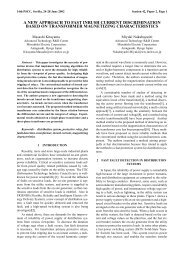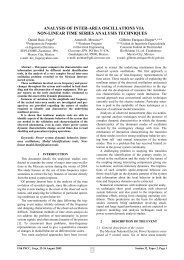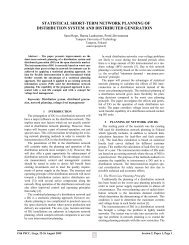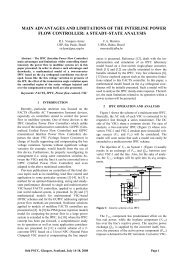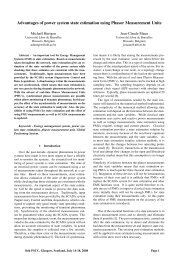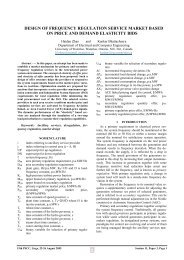comparison of practical fault ride-through capability for mv - PSCC
comparison of practical fault ride-through capability for mv - PSCC
comparison of practical fault ride-through capability for mv - PSCC
Create successful ePaper yourself
Turn your PDF publications into a flip-book with our unique Google optimized e-Paper software.
2.1 Dynamic Model <strong>of</strong> a CHP-plant<br />
Modern CHP-plants have a turbo charged gas engine<br />
as a prime mover. When studying the <strong>ride</strong>-<strong>through</strong> capabilities<br />
<strong>of</strong> such CHP-plants it is necessary to study the<br />
dynamics <strong>of</strong> the gas engine. Gas engine modeling is<br />
very complex due to the difficulties in describing the<br />
internal processes <strong>of</strong> the engine by equations. Most<br />
models which are available in the literature are too specific<br />
and not developed <strong>for</strong> power system dynamical<br />
studies. In [4] a model is developed, which is suitable to<br />
represent the gas engine dynamics. In Figure 1 a block<br />
scheme <strong>of</strong> the gas engine model is given. This block<br />
scheme is implemented in Matlab/Simulink and dynamic<br />
simulations are per<strong>for</strong>med. In [4] a detailed description<br />
<strong>of</strong> the applied model as well as the used figures can be<br />
found.<br />
Throttle<br />
α<br />
1-α<br />
Engine<br />
Turbo<br />
Charger<br />
Figure 1: Block scheme <strong>of</strong> a turbo charged gas engine<br />
Torque<br />
The dynamics <strong>of</strong> the gas engine is demonstrated with<br />
a simulation <strong>of</strong> a torque step. At t = 0 s the engine is<br />
started up and at t = 5 s a torque step from 0.8 p.u. to 0.3<br />
p.u. is applied. The result is depicted in Figure 2 and<br />
shows that the dynamics <strong>of</strong> the gas engine are mainly<br />
determined by the dynamics <strong>of</strong> the throttle.<br />
2.2 Dynamic Model <strong>of</strong> a DFIG<br />
The scheme <strong>of</strong> a DFIG used <strong>for</strong> the simulations is<br />
shown in Figure 3. This concept includes a wound rotor<br />
asynchronous generator with the stator directly connected<br />
to the grid, while the rotor is coupled with the<br />
network using an AC to AC power converter with a DClink.<br />
Wind<br />
Turbine DFIG<br />
1.5 MW 2 MVA<br />
575 V / 10 kV<br />
Pitch<br />
Control<br />
RSC<br />
~<br />
RSC<br />
Control<br />
GSC<br />
~<br />
GSC<br />
Control<br />
150 kvar<br />
Figure 3: Model <strong>of</strong> the DFIG <strong>for</strong> stability assessment<br />
The simulations <strong>of</strong> the DFIG dynamic behavior were<br />
per<strong>for</strong>med with the Matlab/SimPowerSystems toolbox<br />
using the DFIG model available there [5]. The model<br />
includes the following main features:<br />
• The wind turbine is modeled using steady-state<br />
aerodynamic relationship between wind speed<br />
and the mechanical power <strong>of</strong> the turbine.<br />
• The power electronic converters are represented<br />
by equivalent voltage sources generating the AC<br />
voltage averaged over one cycle <strong>of</strong> the switching<br />
frequency.<br />
• Pitch control, rotor-side converter (RSC) and<br />
grid-side converter (GSC) controls are modeled<br />
in full detail. During the simulation the RSC control<br />
operates in power factor regulation mode<br />
keeping the generator reactive power exchange<br />
equal to zero.<br />
Figure 2: Dynamic response <strong>of</strong> a gas engine<br />
In <strong>comparison</strong> with typical <strong>fault</strong> clearing times <strong>of</strong> the<br />
protection systems and critical clearing time <strong>of</strong> generators,<br />
the dynamics <strong>of</strong> the gas engine are slow. Due to<br />
these slow dynamics the gas engine is represented by its<br />
inertia only. This inertia is incorporated with the generator<br />
inertia.<br />
The generator model <strong>of</strong> the CHP-plant, used in the<br />
dynamic simulations, is a regular model <strong>of</strong> the synchronous<br />
machine which is available in PowerFactory.<br />
• The wound rotor asynchronous generator is represented<br />
by 5th order model in the dq-reference<br />
frame.<br />
• The model does not include crowbar protection.<br />
3 TRANSIENT STABILITY OF DG-UNITS<br />
The aim <strong>of</strong> <strong>ride</strong>-<strong>through</strong> criteria is to keep DG-units<br />
connected to the grid during the disturbance and recover<br />
the power balance after <strong>fault</strong> clearing. Keeping DG-units<br />
connected to the grid means that the units have to withstand<br />
certain voltage dips. The effect <strong>of</strong> voltage dips on<br />
stability <strong>of</strong> CHP-plants and wind turbines is studied by<br />
16th <strong>PSCC</strong>, Glasgow, Scotland, July 14-18, 2008 Page 2



